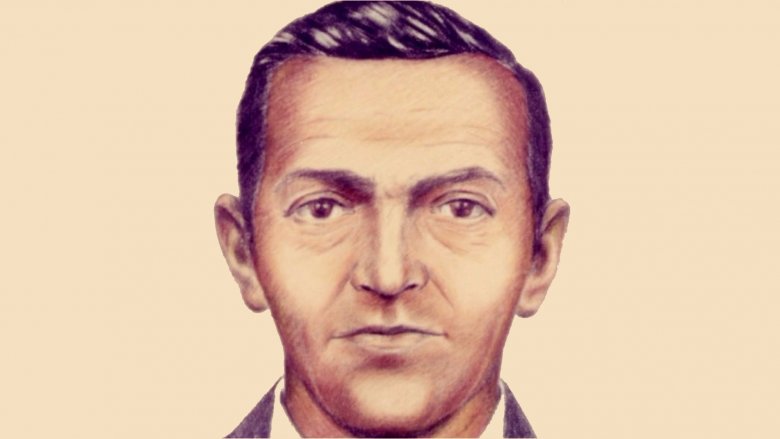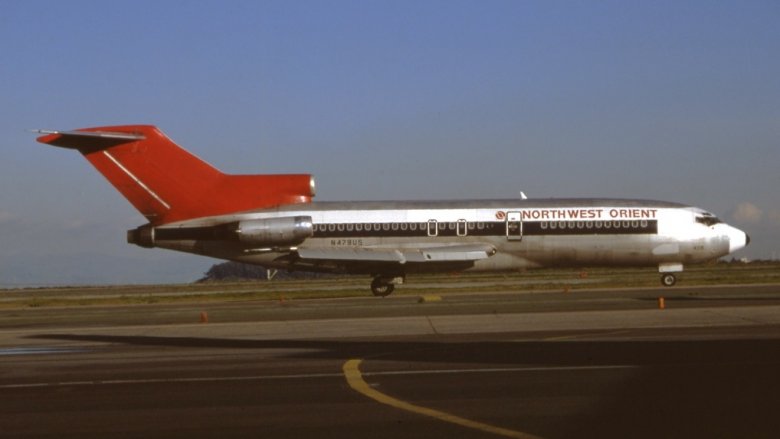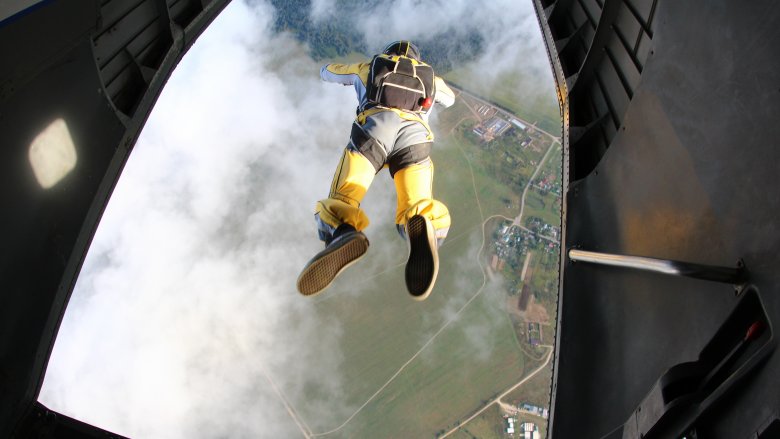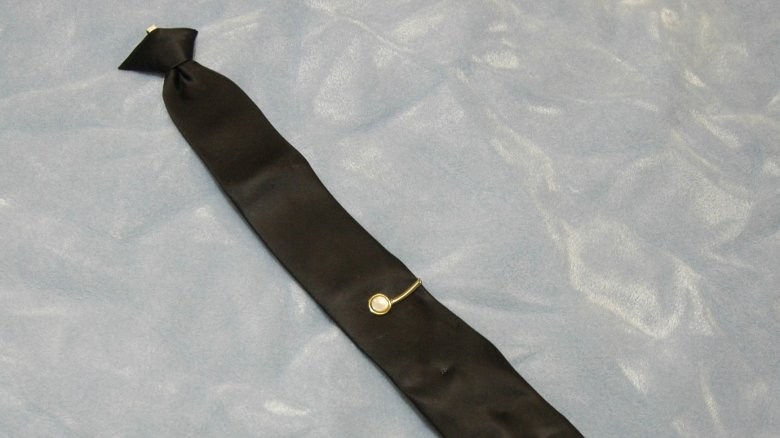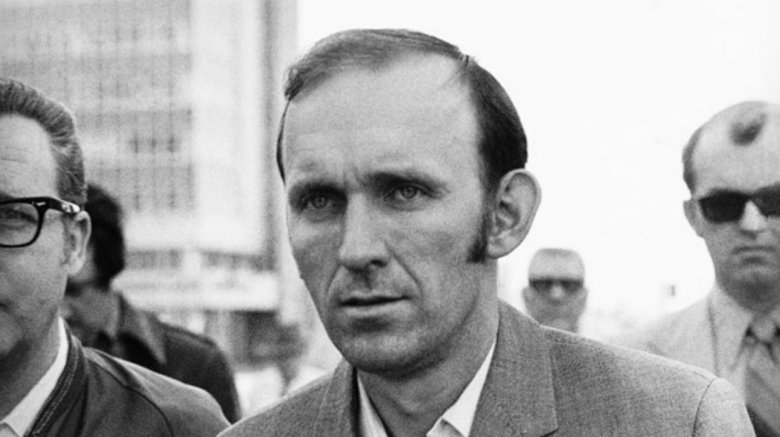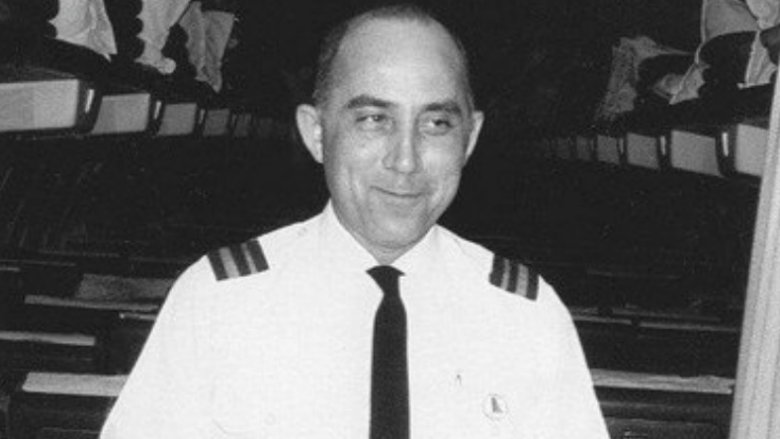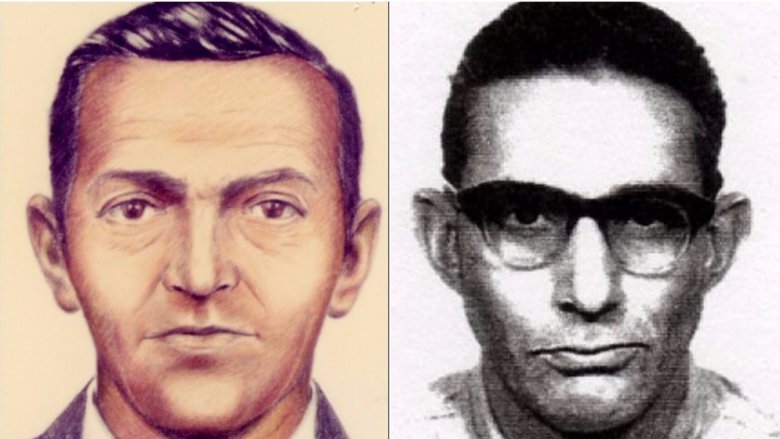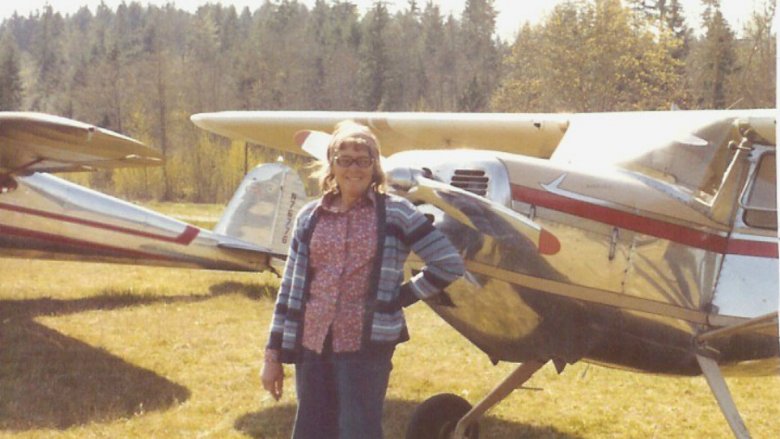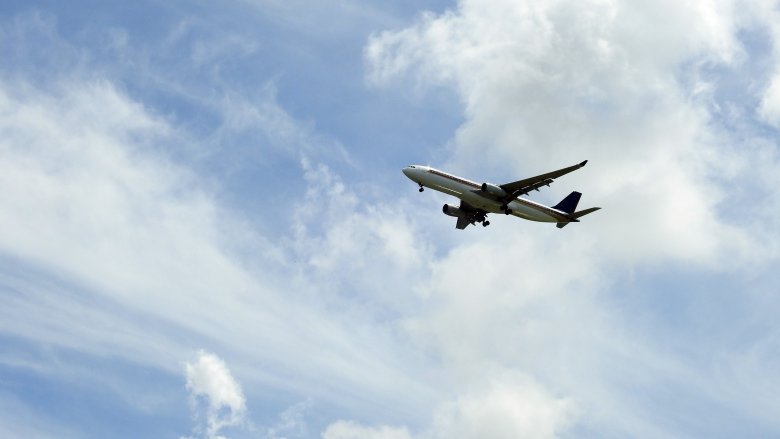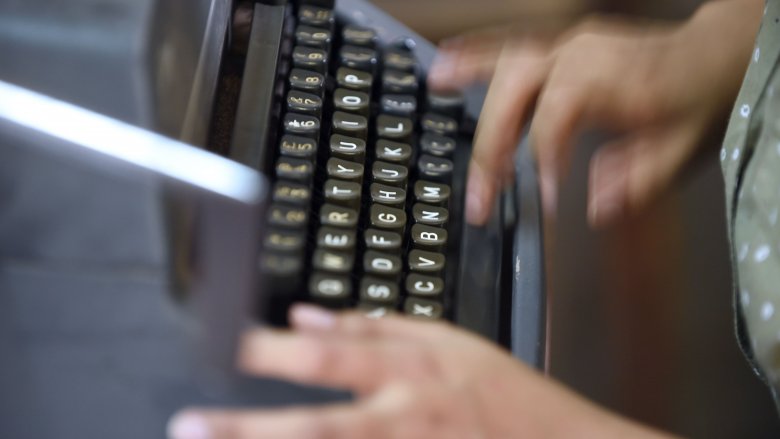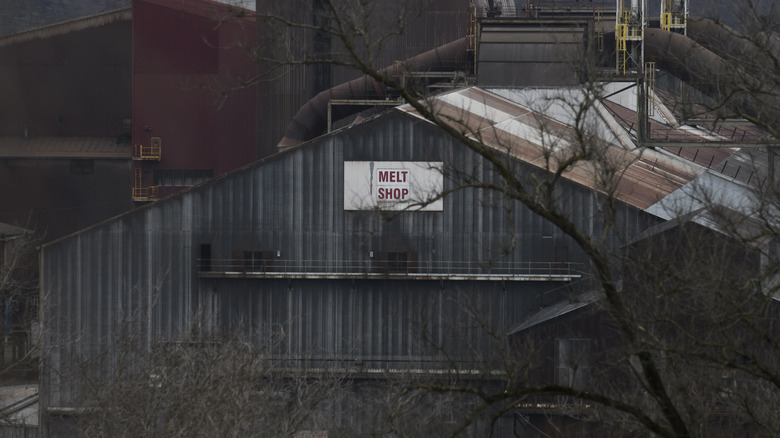The Mystery Of D.B. Cooper
For decades, the case of America's most famous skyjacking has gone unsolved, baffling the FBI and the public, and whetting the appetites of amateur sleuths and conspiracy theorists for decades. Given the lack of hard evidence, reliance on eyewitness testimony, and James Bond-style parachute escape, the mystery of D.B. Cooper has become an American legend. Will the identity of this infamous pirate of the skies ever be unmasked?
Of course there have been lots of theories, some believable, some a bit far-fetched. The story of Cooper's crime and identity has been studied and covered far and wide, with the most recent trend in true crime and amateur, armchair sleuths coming to the table with a fresh set of eyes. Will we ever know who this legendary criminal and mystery man is?
The basics of the case
On November 24, 1971, the day before Thanksgiving, an unidentified man purchased a ticket in cash on Northwest Orient Airlines Flight 305 from Portland to Seattle under the name "Dan Cooper," which became "D.B. Cooper" due to a media miscommunication. Based on eyewitness testimony, Cooper was in his 40s, approximately 5'10" to 6' tall, and weighed 180 pounds with dark hair. He wore a black suit, white shirt, narrow black clip-on tie with pearl tie clip, black overcoat, and brown shoes, and was carrying an attaché case. Cooper ordered a bourbon and soda before takeoff from a flight attendant named Tina Mucklow. Shortly after 3 p.m., Cooper asked Mucklow to come over and handed her a note in all caps reading, "I HAVE A BOMB IN MY BRIEFCASE. I WILL USE IT IF NECESSARY. I WANT YOU TO SIT NEXT TO ME. YOU ARE BEING HIJACKED" (via HistoryNet). Mucklow sat next to Cooper, and he opened his attaché case, revealing wires and colored sticks. Cooper dictated another note demanding four parachutes and $200,000 in $20 bills, and Mucklow delivered the note to the pilots.
When the plane landed in Seattle, Cooper exchanged the passengers for the parachutes and money, forcing the crew to return to the plane with him. They took off once more, setting a course for Mexico and flying no higher than 10,000 feet. A little past 8 p.m., Cooper jumped from the plane with the cash into a remote wilderness area somewhere between Seattle and Reno, stunning the crew. His whereabouts and identity are unknown.
Could D.B. Cooper have survived?
Other than D.B. Cooper's true identity, the biggest mystery surrounding the case is what happened after his dramatic parachute exit from the plane. Investigators and sleuths are split. The evidence suggests Cooper died. The FBI noted Cooper jumped from the plane at night into a wooded wilderness area. His parachute was incapable of being steered, and his clothing was more suitable for a wedding or day at the office than a jump from a Boeing jet. Special Agent Larry Carr, a Seattle-based member of the Bureau who took over the case in the 2000s, concluded, "No experienced parachutist would have jumped in the pitch-black night, in the rain, with a 200-mile-an-hour wind in his face, wearing loafers and a trench coat. It was simply too risky. He also missed that his reserve chute was only for training and had been sewn shut—something a skilled skydiver would have checked." Plus, some of the ransom money was recovered in 1980 when a young boy found a package of rotting $20 bills on the beach of the Columbia River near Vancouver; another piece of evidence pointing to Cooper's death.
Still, the FBI has investigated about 1,000 suspects total, narrowing down their list over the years to just two dozen persons of interest. If Cooper did land safely and is still alive, he'd be in his late 80s or early 90s today, so perhaps someone should scope out the Florida retirement community scene.
Key pieces of evidence
Certainly the 1980 recovery of a portion of the ransom money was a major break in the investigation. However, it's D.B. Cooper's black clip-on tie, which he removed prior to his jump, that has provided investigators with the most information. The FBI discovered three different DNA samples on the tie in 2007, but there's no way of knowing if any of the DNA belonged to Cooper. None of the main suspects in the case have been a match so far, leaving investigators just as befuddled as they were before its discovery. Without knowing whether the DNA on the tie is even Cooper's, even if the FBI could match it to a suspect, it's not enough evidence to positively identify the hijacker.
However, a group of amateur investigators named Citizen Sleuths have discovered other forensic evidence that may give us clues about Cooper's real identity. The group, comprised of scientists from around the country, has been reevaluating the case after consulting with the FBI. In early 2017, the Citizen Sleuths ran a full-scale analysis of the tie using an electron microscope that turned up over 100,000 particles, including titanium and other corrosion-resistant metals. Based on that analysis, the group believes Cooper may have worked in the aerospace or electronics industries, which would have given him intimate knowledge of airplane machinery and put him in contact with the kinds of metallic elements found on his tie. Too bad the tie isn't enough to tie anyone yet to the case. It was a clip-on after all.
Richard Floyd McCoy
One of the higher-profile suspects in the case, Richard Floyd McCoy was arrested by the FBI for a similar airplane hijacking just five months after D.B. Cooper's flight. McCoy's 1972 copycat crime even ended with a parachute jump like Cooper's. McCoy was a 29-year-old Vietnam veteran and former helicopter pilot with skydiving experience. According to the FBI, McCoy was part of the Utah Air National Guard, was studying law at Brigham Young University, and had a history of financial problems. Though McCoy denied involvement in the 1972 crime, handwriting and fingerprint analyses matched evidence obtained from the plane, leading to his arrest. Upon a search of his home, agents uncovered nearly $500,000. The U.S. District Court sentenced McCoy to 45 years in prison for his crimes.
However, the FBI eliminated McCoy as a suspect for the D.B. Cooper case based mostly on eyewitness descriptions of Cooper. McCoy was too young and didn't quite match Cooper's height and weight. Despite the similarities of their hijacking cases, too many details suggest McCoy was merely a copycat and not the actual D.B. Cooper. In a dramatic turn, McCoy escaped prison in 1974 and was killed in a shootout with the FBI in Virginia Beach a few days later. Now that's a criminal who's the real McCoy.
Lynn Doyle Cooper
In 2011, a woman named Marla Cooper publicly suggested her uncle Lynn Doyle ("L.D.") was actually D.B. Cooper. Lynn Cooper grew up in Oregon and knew the area where the hijacker jumped, a key piece of information matching the FBI's theory that the hijacker was familiar with the Pacific Northwest. Lynn Cooper was also a Korean War veteran who had experience jumping from planes. Marla, who was 8 at the time of the 1971 hijacking, remembers her uncles plotting something a few days before Thanksgiving in Utah and then leaving to go turkey hunting. She said when L.D. returned after the hijacking, he looked beat up and claimed he'd been in a car accident. She told ABC News (via The New York Times) she recalled her uncles saying "our money problems are over. We hijacked an airplane." L.D. left a few days later and checked into a VA hospital. He briefly reunited with his family at Christmas in 1972, but that was the last time Marla saw him. Just before her father died in 1995, Marla said he mentioned the hijacked airplane and that he believed his estranged brother was hiding from the FBI. L.D. died in 1999.
After Marla came forward in 2011, the FBI collected a DNA sample from L.D.'s daughter. Although the DNA did not match up with the DNA found on D.B. Cooper's clip-on tie, the FBI has never formally ruled out Lynn Doyle Cooper as a suspect because the tie DNA isn't proven to be D.B. Cooper's. Marla remains convinced her uncle was the real culprit behind the skyjacking, but hey, everyone has at least one crazy uncle, right?
Kenneth Christiansen
Kenneth Christiansen was a paratrooper who later worked as a mechanic and flight purser for Northwest Orient Airlines, the same carrier D.B. Cooper hijacked in 1971. A resident of Washington, Kenneth became a suspect after his brother, Lyle Christiansen , contacted a private investigator in New York seeking out writer/director Nora Ephron's contact information to make a movie about his brother's supposed involvement in the skyjacking. New York Magazine notes Lyle made the connection between Cooper and his brother after watching an episode of "Unsolved Mysteries" and seeing the composite sketch of Cooper. "I sat up in my chair," he recalled, "because my brother was a dead ringer."
Kenneth grew up during the Great Depression and developed a fascination with $20 bills after watching his prizefighter father get paid with them. Lyle noted Kenneth was quiet, liked bourbon, and always seemed to have extra money around. Not long before his death, Kenneth pulled Lyle to him and said, "There is something you should know, but I cannot tell you!" Nothing like a vague deathbed confession to stir up family drama! While Northwest flight attendant Florence Schaffner saw a lot of similarities between Christiansen's picture and the official FBI sketch of Cooper, she wasn't entirely convinced they were the same man. Nor was the FBI, which noted his height, weight, and eye color didn't match Cooper's physical description. Still, there's enough circumstantial evidence surrounding Kenneth Christiansen that he's a lasting person of interest in the case.
Duane Weber
In 1995, Duane Weber called his wife, Jo, to the Florida hospital bed where he was dying from kidney disease and confessed: "I have a secret to tell you. ... I'm Dan Cooper" (via CBS). Weber was in his late 40s at the time of the skyjacking, was 6'1" and drank bourbon like Cooper. A World War II veteran, Weber did plenty of time in prison from 1945 to 1968 for both burglary and forgery, which made him a person of interest to the FBI. After his death, Jo started recalling details that seemed to implicate her husband. She told CBS News he had talked in his sleep once about "leaving fingerprints on a plane," which she found curious. He'd also mentioned an old injury he'd sustained as a result of jumping from a plane.
During a vacation in late 1979, the Webers stopped at the Columbia River. Duane walked it alone for a while, near the spot where part of Cooper's ransom money was discovered just a few months later in 1980. Though it may have simply been a coincidence, Jo thought otherwise. Even the lead investigator on the case at the time, Ralph Himmelsbach, and an FBI forensic sketch artist confirmed a number of physical similarities between the younger Weber and the D.B. Cooper sketch. However, the FBI officially ruled Weber out after running DNA tests in the early 2000s. For once, the cons outweighed the pros for this con of a suspect.
Barbara Dayton
Of all the suspects in the D.B. Cooper case, Barbara Dayton might be the most far-fetched. (For a dramatic case like this one, that's saying something.) Dayton, born Robert, was the recipient of Washington state's first gender reassignment surgery in 1969. Dayton had been a pilot and had skydiving experience thanks to her service during World War II.
According to Dayton's friends, authors Pat and Ron Forman, Barbara also had experience with explosives and machinery, two things that fit D.B. Cooper's profile. The Formans befriended Dayton in the late 1970s when they began sharing a hangar at Thun Field in Puyallup, Washington. Dayton and the couple would go flying together nearly every weekend, and over time, Dayton opened up to the Formans about her past as a man and her involvement in the skyjacking. They claim Dayton owed back taxes and was frustrated by a number of issues related to her gender identity, so she reverted to her male persona and hijacked the Northwest Airlines flight.
"Barb was a woman who always lived on the edge," they told The Mountain News, "a fascinating remarkable woman." Though many of her personality traits and aviation abilities fit the profile, the FBI never formally commented on Barbara Dayton or the Formans' claims. Dayton passed away in 2002 from natural causes.
Cultural impact
D.B. Cooper has become an American legend over the years thanks to the mysterious nature of the case. Not only did he inspire several copycat crimes (including one committed by suspect Richard Floyd McCoy), but he captured the nation's attention. People everywhere wanted to cash in on Cooper's folkloric popularity. Shirts emblazoned with "D.B. Cooper, Where are you?" popped up, as per The New York Times, and radio stations played songs dedicated to the skyjacker. Con men ran schemes. Cooper-inspired novels like James M. Cain's "Rainbow's End" and true-crime books like Geoffrey Gray's "Skyjack: the Hunt for D.B. Cooper." A 1981 adventure film starring Treat Williams and Robert Duvall called "The Pursuit of D.B. Cooper" was released to poor reviews, while 2004 comedy "Without a Paddle" focused on friends seeking out Cooper's missing ransom money.
The one place Cooper will never die is the internet, of course. On Reddit, the case is a popular topic, and "Mad Men" fans theorized character Don Draper would become the skyjacker at the end of the series. If you want to meet other Cooper enthusiasts in person, head to the annual D.B. Cooper Days in Ariel, Washington, for beer, costume contests, live music, and friendly debates. Cooper's most lasting impact may just be on the airline industry, which installed something called the "Cooper Vane" after the skyjacking to prevent anyone from using the rear stairs during a flight. There's really no escaping those extra luggage fees now.
Status of the case now
On July 12, 2016, the FBI formally closed the D.B. Cooper case after what it called "one of the longest and most exhaustive investigations in our history." The Bureau stated it had followed all credible leads and evidence but was unable to positively identify D.B. Cooper or his whereabouts. After the investigation ended, the Citizen Sleuths asked to reevaluate all the FBI's evidence for more information and leads.
The 46-year-old case remains an unsolved mystery despite the Citizen Sleuths' aforementioned discovery of metallic particles on Cooper's tie in early 2017. They remain committed to looking for new evidence while reexamining old evidence, calling the case a "work in progress" on their website. For now, D.B. Cooper is still lost in the ether of American aviation history and folklore ... right?
Other possible suspects
Just because the FBI isn't on the case anymore doesn't mean everyone's given up. In May 2018, an 84-year-old pet sitter named Carl Laurin described how his longtime friend, Walter R. Reca, had admitted to being D.B. Cooper. Of course, Reca forbade Laurin from sharing his story before his death. Reca, a former paratrooper and intelligence agent, died in 2014. "It feels like something he would do," Laurin told The Washington Post. Laurin's publisher had a Michigan police officer vet his claims and became so convinced that they just felt they had to publish. Of course, this particular police officer also led the investigation into Jimmy Hoffa's disappearance, so maybe take his conclusions with a grain of salt.
A couple months later, in July, more D.B. Cooper headlines were made. This time, a 40-person team of investigators (many of them ex-FBI) announced that the real Cooper was Robert Rackstraw, now a 70-something Vietnam veteran. Rackstraw was former Special Forces, had lots of other relevant work experience, and had used at least 22 aliases through the years. Their main evidence was a handful of typewritten letters sent to different newspapers back in the day, which they said could be decoded into confessions. The team also claimed the FBI had protected Rackstraw because he knew too many government secrets. Rackstraw still lives in San Francisco, and when asked about the allegations he "did not confirm or deny anything, telling the reporter to 'verify [the] facts,'" according to Rolling Stone. So that settles that!
The Pittsburgh titanium connection
Investigator Eric Ulis applies contemporary technology and methodology to unlock unsolved mysteries of the past. He's appeared on numerous documentary television programs and wrote a book about the hunt for the man who hijacked a plane near Seattle in 1971 known only as "D.B. Cooper." In 2024, Ulis announced a potentially major breakthrough in the struggle to pinpoint the true identity of the hijacker.
Investigators used small segments of carbon to extract around 100,000 microscopic particles from minuscule metal shards on a clip-on tie that Cooper left on the plane. Those particles consisted primarily of titanium and stainless steel, and after Ulis cross-referenced that data with U.S. patents, it led him to Crucible Steel. "Headquartered in the suburbs of Pittsburgh, a significant subcontractor all throughout the 1960s," Ulis told Fox 13 Seattle. "It supplied the lion's share of titanium and stainless steel for Boeing's aircraft."
The plane D.B. Cooper hijacked: a Boeing 727. If Cooper were a Crucible Steel employee, as the metal particles on his tie would suggest, he would have been familiar with the setup and operations of that plane as well as the Seattle area, where Boeing was headquartered. Those clues point to one person, according to Ulis: Crucible's titanium research engineer Vince Peterson. "I can put him in Seattle, I can put him at Boeing. He's a compelling person of interest," Ulis said of the latest hijacking suspect — who died in 2002.
